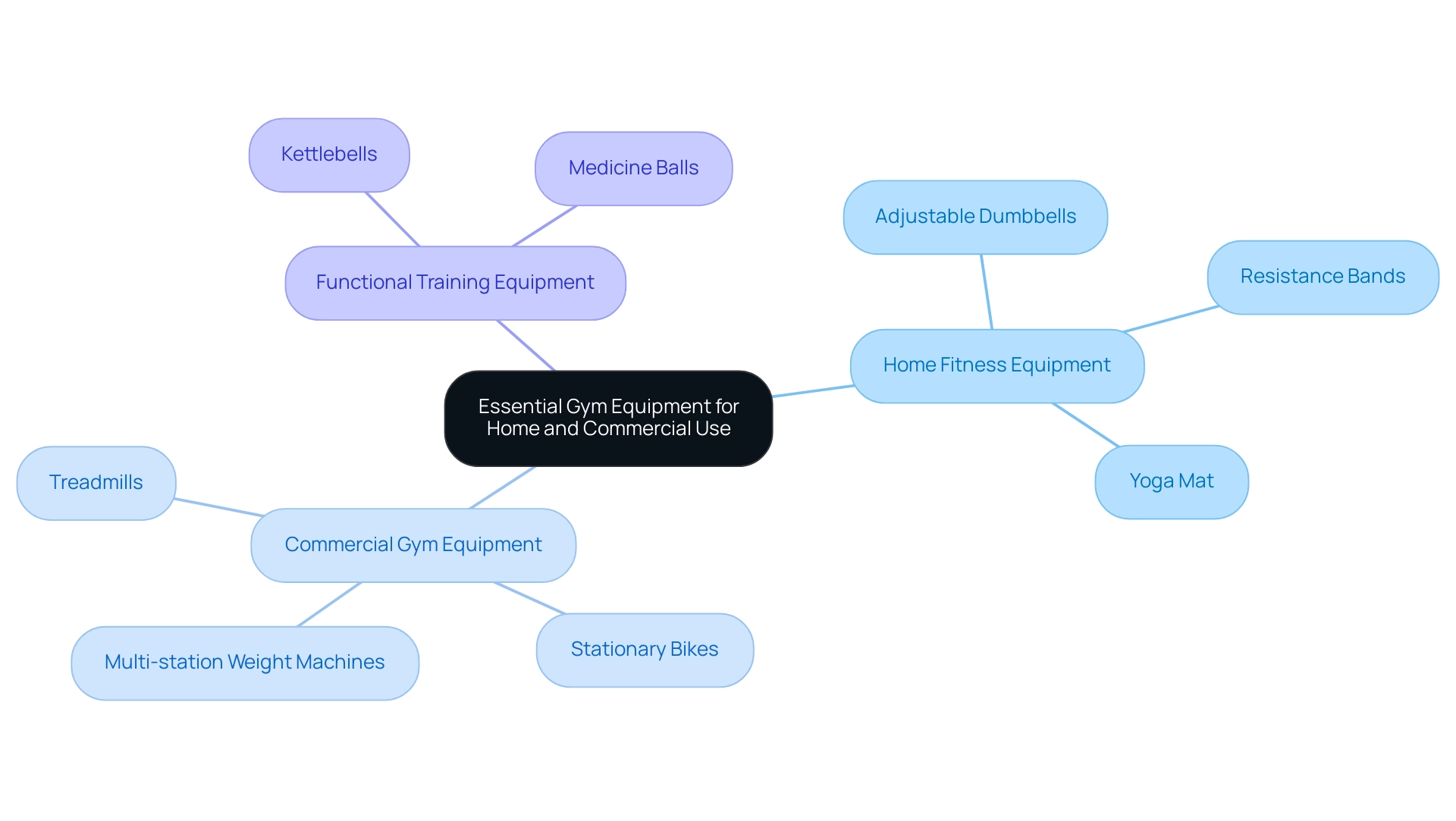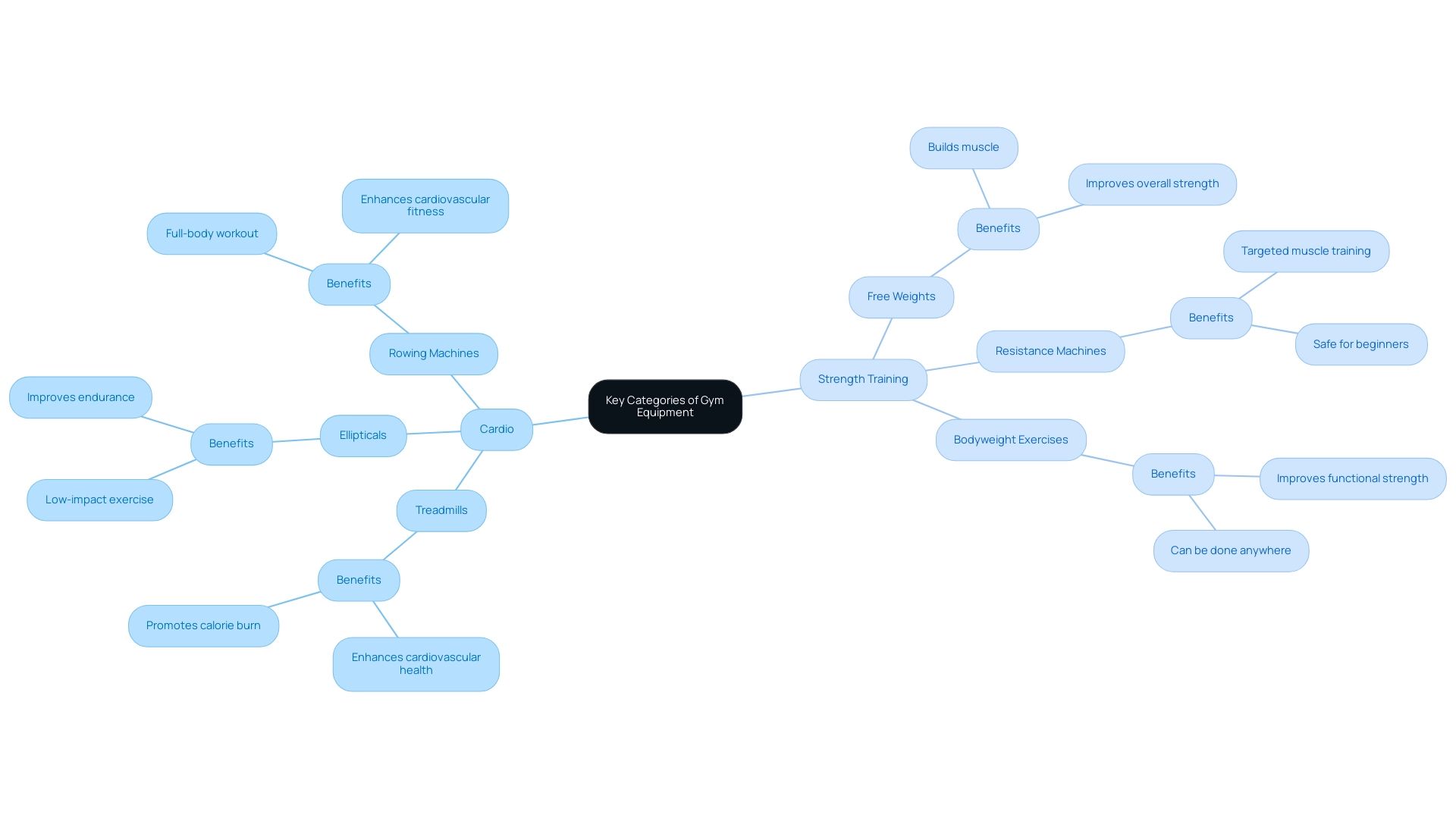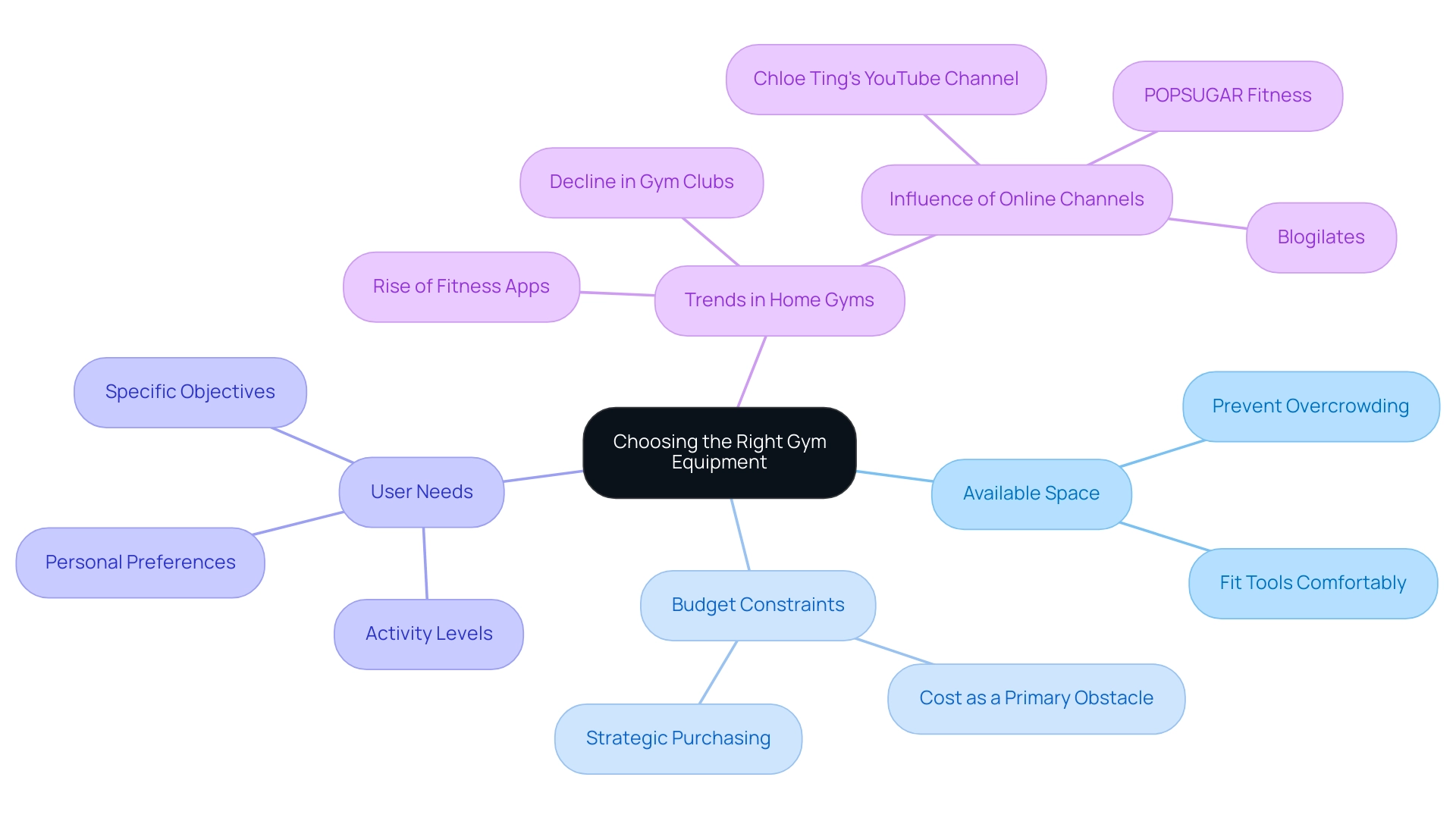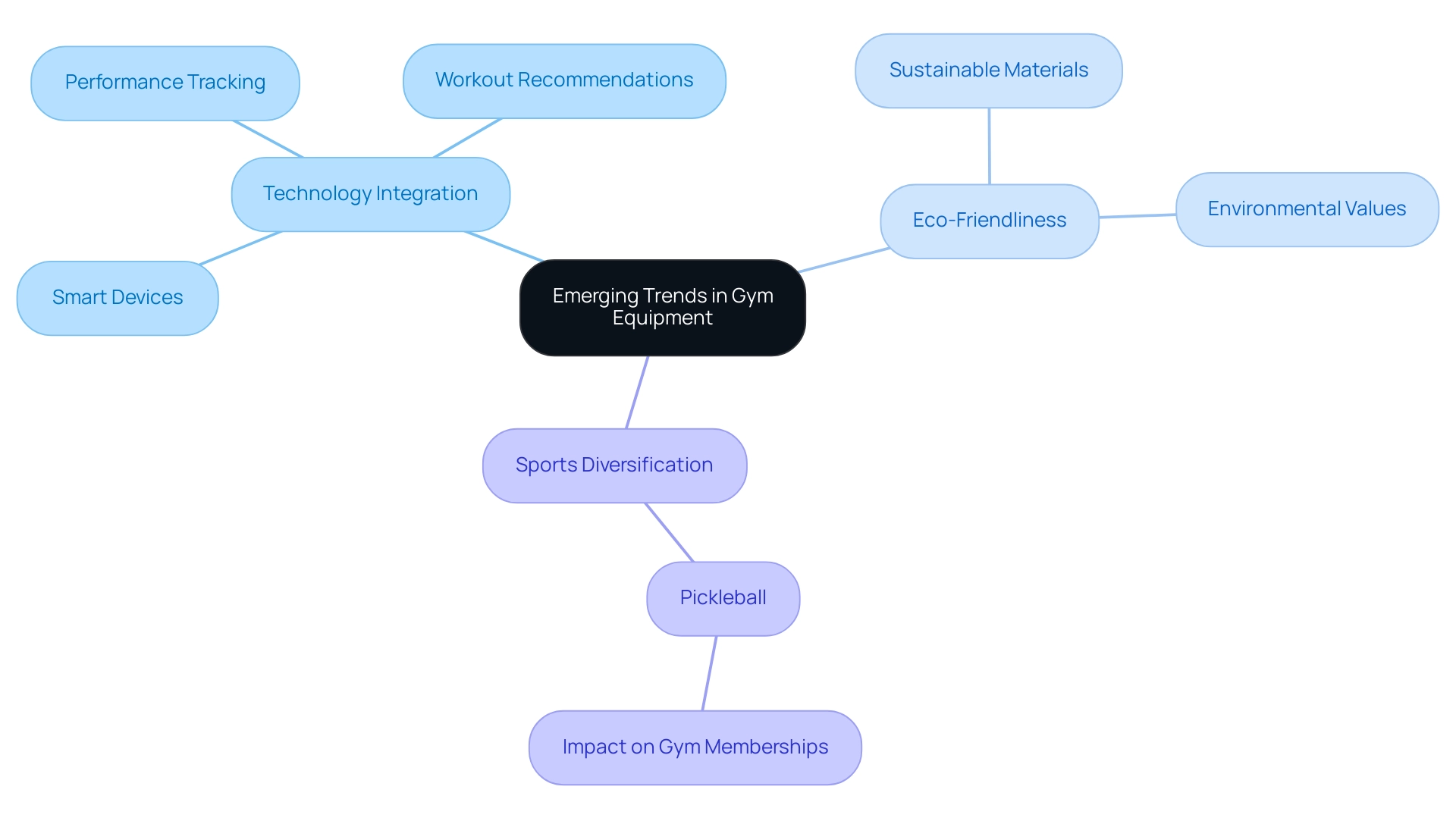Overview
The article focuses on essential gym equipment choices for both home and commercial gyms, emphasizing the importance of versatility and the integration of technology in fitness tools. It supports this by outlining key equipment types—such as adjustable dumbbells for home use and multi-station machines for commercial gyms—while also highlighting emerging trends like eco-friendly options and smart devices that enhance user engagement and promote a culture of health and wellness.
Introduction
In a world increasingly focused on health and wellness, the importance of equipping both home and commercial gyms with the right tools cannot be overstated. As organizations strive to cultivate a culture of fitness, understanding the essential pieces of equipment that support diverse workout needs becomes paramount. From adjustable dumbbells that maximize space in home setups to multi-station machines that cater to a variety of fitness levels in commercial environments, the choices made today can significantly influence employee well-being and engagement.
With trends indicating a surge in home gym popularity and a growing commitment to fitness across the nation, HR Benefits Managers have a unique opportunity to transform their teams' health journeys. By prioritizing versatile and effective gym equipment, they can foster an environment where wellness thrives, ultimately leading to a more motivated and productive workforce.
Essential Gym Equipment for Home and Commercial Use
When assessing gym apparatus for both home and commercial use, several essential pieces emerge as key players in promoting wellness. For home fitness setups, adjustable dumbbells and resistance bands are invaluable due to their versatility, allowing users to engage in a variety of workouts without taking up excessive space. A quality yoga mat also plays a crucial role in enhancing comfort during exercises.
In contrast, commercial gyms must cater to a larger clientele, necessitating more extensive equipment such as:
- Treadmills
- Stationary bikes
- Multi-station weight machines
These can accommodate diverse exercise levels and preferences. Additionally, both environments gain significantly from integrating functional training equipment such as kettlebells and medicine balls, which are crucial in improving strength and cardiovascular health. Recent trends indicate a significant surge in interest toward home gym setups, with sales projected to continue rising in 2024.
As of 2020, an estimated 71.5 million Americans were members of a health club, reflecting a growing commitment to well-being and exercise. Additionally, U.S. sporting goods sales surged from $22.6 million in 2019 to $40.5 million in 2021, marking a 38.93% growth largely due to pandemic-driven changes in consumer behavior. As Jonathan Weissberg, fitness research director, notes, "If you have any questions about the information mentioned above, or are interested in an interview, please feel free to get in touch with Jonathan Weissberg."
By understanding these essential components, HR Benefits Managers can create effective workout spaces that not only meet the needs of their teams but also inspire a culture of health and well-being.

Key Categories of Gym Equipment: Cardio vs. Strength Training
To support workplace wellness, it is essential to understand that gym tools must have gym equipment that is fundamentally divided into two key categories: cardio and strength training. Cardio equipment—including treadmills, ellipticals, and rowing machines—plays an essential role in enhancing cardiovascular health and promoting calorie burn. In contrast, strength training tools such as free weights, resistance machines, and bodyweight exercises are crucial for building muscle and improving overall strength.
As highlighted by Barbara Sternfeld, Ph.D., FACSM, > Staying Independent Later in Life: The Role of Midlife Physical Activity <, engaging in both modalities is crucial for maintaining health and functionality as we age. A balanced exercise program that incorporates both cardio and strength training not only supports heart health but also enhances metabolic function and muscle development.
Recent trends indicate a growing recognition of this balance, with the sporting goods store industry in the US valued at approximately $48 billion annually, and online sales comprising about 35% of total sales. This shift reflects a rising demand for diverse equipment, as there must have gym equipment that caters to comprehensive health needs. Additionally, home workouts can save individuals up to $1,000 annually compared to gym memberships, providing a financial incentive for workplace wellness programs.
Moreover, emerging research on exercise modalities suggests that the physiological adaptations resulting from exercise are more influenced by the intensity exerted rather than the specific type of training. Recent studies have attempted to compare exercise modalities while controlling for effort and duration, reinforcing the importance of effort in achieving health outcomes. This insight underscores that both cardio and strength training are indispensable for a well-rounded fitness approach.
By understanding these distinctions and trends, HR Benefits Managers can foster a comprehensive workout plan that must have gym equipment to effectively address all dimensions of health and well-being for their teams.

The Importance of Versatility in Gym Equipment Choices
Versatile gym equipment, which must have gym equipment like resistance bands, adjustable dumbbells, and multi-functional benches, empowers users to engage in a wide array of exercises that target various muscle groups. This adaptability is especially crucial in home gym setups, where space constraints can limit options. The increase in exercise bench sales, which reached an impressive $214.6 million—up 77.94% from 2019—reflects a growing acknowledgment of the need for flexibility in workout tools.
Furthermore, programs such as SilverSneakers, which has more than 15 million members and provides access to over 16,000 facilities, emphasize the rising trend of physical activity involvement, especially among older adults, making it pertinent for workplace wellness initiatives. For commercial fitness centers, investing in adaptable tools that must have gym equipment ensures that a varied clientele can find exercises suited to their personal health objectives. To maintain their routines dynamic and enjoyable, users must have gym equipment, which helps foster long-term dedication to their wellness journeys.
As one exercise specialist aptly stated, 'Home gyms are also more convenient than gym memberships because they’re right at home, making it much simpler for you to incorporate training into your day.' This convenience not only enhances engagement but also promotes better cardiovascular health and higher calorie burn, vital considerations for any workplace wellness initiative. Moreover, the emerging trend of indoor racing illustrates the evolving landscape of exercise, showcasing how versatile equipment can cater to diverse training preferences.
A case study titled 'Convenience in Workout Planning' demonstrates how versatile gym machines, which must have gym equipment, facilitate easy workout planning by allowing users to perform various exercises on a single machine, minimizing the hassle of adjusting routines. This convenience helps users maintain consistency and motivation, ultimately leading to improved workplace performance and emotional well-being. To support these initiatives, Foresight Health Coaching offers tailored corporate memberships that include access to our health and wellness app, providing personalized training coaching and custom program development to ensure lasting lifestyle changes.
Studies have shown that employees who exercise regularly report feeling more motivated and engaged at work, further emphasizing the importance of integrating fitness into the workplace.

Choosing the Right Gym Equipment: Key Considerations
Choosing the right gym apparatus must have gym equipment considerations involving careful evaluation of several pivotal factors. First and foremost, assessing the available space is essential for home gym owners. Ensuring that tools fit comfortably within the designated area prevents overcrowding and creates an inviting workout environment.
Budgetary limitations also have an important impact; indeed, a recent statistic indicates that 35.6% of US exercises mention cost as the primary obstacle to acquiring workout tools. Comprehending that high-quality tools varies widely in price enables more strategic purchasing. Focusing on vital items that align with personal health objectives is a prudent strategy, as it prevents the frequent mistake of obtaining items that must have gym equipment but eventually remain idle.
Aishwarya Mehra observes,
Exercise applications have transformed the way individuals tackle their routines, providing convenience, personalization, and accessibility to workouts and wellness programs.
This sentiment highlights the significance of comprehending user needs—such as activity levels, preferences, and specific objectives—when choosing tools. Furthermore, the decline in gym clubs, which peaked at 41,370 in 2019 but saw a significant drop in 2020, emphasizes the growing trend of home gym setups.
By recognizing these shifts, HR Benefits Managers must have gym equipment to better understand the importance of choosing suitable tools. Additionally, popular workout channels like Chloe Ting’s YouTube channel have demonstrated high engagement levels, influencing how individuals approach their exercise routines. By doing so, HR Benefits Managers can ensure that the selected tools promote a sustainable and enjoyable exercise experience, ultimately enhancing workplace wellness initiatives.

Emerging Trends in Gym Equipment: What to Look For
The gym equipment landscape is rapidly evolving, and it must have gym equipment that integrates technology, transforming the way exercise is approached. Smart devices are at the forefront, allowing users to track performance metrics and receive personalized workout recommendations tailored to their individual goals. This seamless connectivity, including features like Bluetooth compatibility, empowers individuals to sync their routines with various exercise applications, enhancing motivation and accountability.
Notably, the trend towards eco-friendly gym equipment is gaining traction, as organizations increasingly prioritize sustainability. With over 71.5 million Americans as members of fitness clubs in 2020 and 1.2 billion downloads for health and fitness apps in the US in 2022, there is a clear growing demand for innovative solutions that not only facilitate fitness but also align with environmental values. Additionally, the rise of pickleball, one of America's fastest-growing sports, illustrates how gyms can attract new members by diversifying their offerings.
By staying abreast of these emerging trends, HR Benefits Managers can make informed decisions that enhance workplace wellness, create a positive impact on employee health, and promote a culture of sustainability within their organizations. Investing in the latest gym equipment technology must have gym equipment as a crucial step toward fostering a healthier, more engaged workforce.

Conclusion
Equipping home and commercial gyms with the right tools is essential for promoting a culture of health and wellness within organizations. The article highlights the importance of versatile gym equipment, such as adjustable dumbbells and multi-station machines, which cater to diverse fitness levels and preferences. As trends indicate a growing commitment to fitness, HR Benefits Managers have the opportunity to create effective workout spaces that inspire employees to prioritize their health.
The balance between cardio and strength training is crucial for overall well-being, emphasizing that both modalities are vital components of a comprehensive fitness program. By understanding the key considerations in selecting gym equipment—such as available space, budget, and user needs—managers can ensure that their teams have access to tools that foster engagement and motivation.
Moreover, the emergence of technology in gym equipment and the growing demand for eco-friendly options reflect a shift towards more innovative and sustainable fitness solutions. By staying informed about these trends and investing in the right equipment, HR Benefits Managers can cultivate a thriving environment that supports employee wellness, enhances productivity, and ultimately leads to a more motivated workforce. The time to act is now; prioritizing fitness tools is a powerful step towards transforming health journeys within the workplace.
Frequently Asked Questions
What are the essential gym apparatus for home fitness setups?
Key pieces of gym apparatus for home fitness include adjustable dumbbells, resistance bands, and a quality yoga mat. These items are versatile and do not take up excessive space.
What equipment is necessary for commercial gyms?
Commercial gyms require more extensive equipment to cater to a larger clientele, including treadmills, stationary bikes, and multi-station weight machines.
Why is functional training equipment important in both home and commercial gyms?
Functional training equipment, such as kettlebells and medicine balls, is crucial for improving strength and cardiovascular health, benefiting users in both home and commercial settings.
What trends are emerging in the home gym market?
There is a significant surge in interest toward home gym setups, with sales projected to continue rising in 2024.
How many Americans were members of health clubs as of 2020?
As of 2020, an estimated 71.5 million Americans were members of a health club, indicating a growing commitment to well-being and exercise.
What was the growth in U.S. sporting goods sales from 2019 to 2021?
U.S. sporting goods sales increased from $22.6 million in 2019 to $40.5 million in 2021, marking a 38.93% growth primarily due to pandemic-driven changes in consumer behavior.
How are gym tools categorized for workplace wellness?
Gym tools are fundamentally divided into two key categories: cardio equipment (e.g., treadmills, ellipticals, rowing machines) for enhancing cardiovascular health, and strength training tools (e.g., free weights, resistance machines) for building muscle and improving overall strength.
Why is a balanced exercise program important as we age?
Engaging in both cardio and strength training is essential for maintaining health and functionality as we age, supporting heart health, metabolic function, and muscle development.
What is the annual valuation of the sporting goods store industry in the U.S.?
The sporting goods store industry in the U.S. is valued at approximately $48 billion annually, with online sales making up about 35% of total sales.
How can home workouts benefit individuals financially?
Home workouts can save individuals up to $1,000 annually compared to gym memberships, providing a financial incentive for workplace wellness programs.
What recent research suggests about exercise modalities?
Emerging research indicates that the physiological adaptations from exercise are more influenced by the intensity exerted rather than the specific type of training, highlighting the importance of effort in achieving health outcomes.

